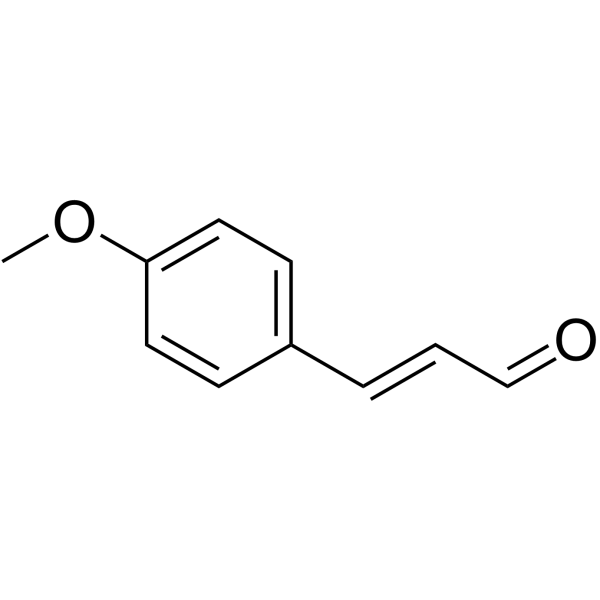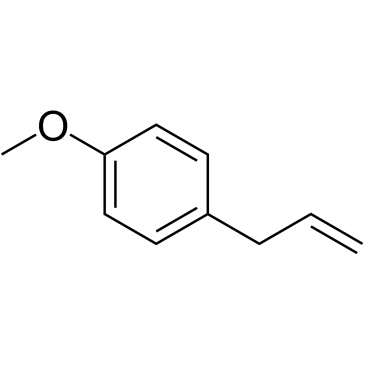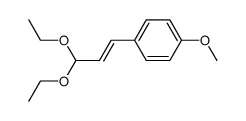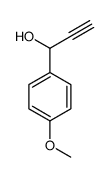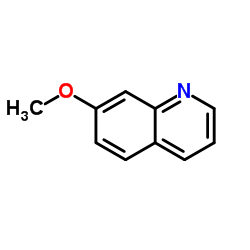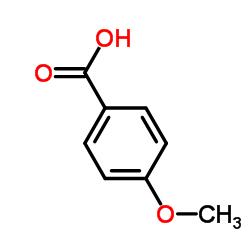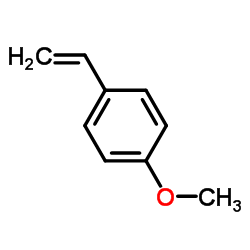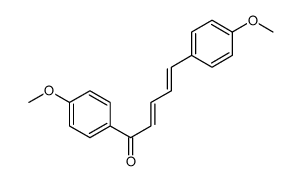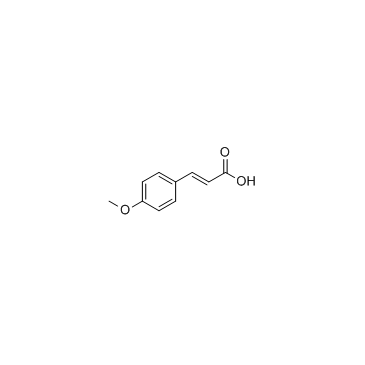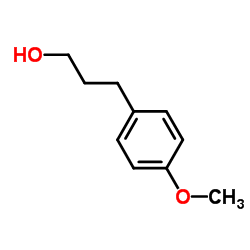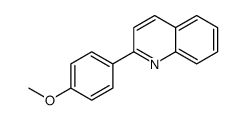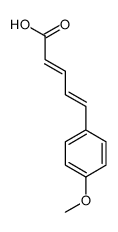1963-36-6
| 中文名 | 4-甲氧基肉桂醛 |
|---|---|
| 英文名 | p-Methoxycinnamic aldehyde |
| 中文别名 |
3-(4-甲氧基苯基)-2-丙烯醛
4-甲氧基肉桂苯醛 |
| 英文别名 |
3-(4-Methoxyphenyl)-2-propenal
3-p-methoxyphenyl-2-propenal p-Methoxycinnamaldehyde 4-Methoxycinnamaldehyde 2-Propenal, 3-(4-methoxyphenyl)- 4-Methoxybenzeneacrolein Einecs 217-807-0 4-Methoxyciamaldehyde Fema no. 3567 3-(4-Methoxyphenyl)acrylaldehyde VH1U1R DO1 trans-4-Methoxycinnamaldehyde para-methoxycinnamaldehyde Methoxycinnamaldehyde,p 4-Methoxybenzenepropenal |
| 描述 | 4-甲氧基肉桂醛是藿香的活性成分,在人喉癌细胞系中对呼吸道合胞病毒(RSV)具有细胞保护活性。4-甲氧基肉桂醛有效抑制RSV的细胞病变作用,估计IC50为0.055μg/mL[1]。 |
|---|---|
| 相关类别 | |
| 参考文献 |
| 密度 | 1.1±0.1 g/cm3 |
|---|---|
| 沸点 | 308.7±17.0 °C at 760 mmHg |
| 熔点 | 55-60ºC(lit.) |
| 分子式 | C10H10O2 |
| 分子量 | 162.185 |
| 闪点 | 146.5±14.5 °C |
| 精确质量 | 162.068085 |
| PSA | 26.30000 |
| LogP | 2.07 |
| 蒸汽压 | 0.0±0.7 mmHg at 25°C |
| 折射率 | 1.559 |
| 储存条件 | 保持贮藏器密封、储存在阴凉、干燥的地方,确保工作间有良好的通风或排气装置 |
| 稳定性 | 如果遵照规格使用和储存则不会分解,未有已知危险反应,避免氧化物 |
| 分子结构 | 1、 摩尔折射率:49.00 2、 摩尔体积(m3/mol):151.7 3、 等张比容(90.2K):375.7 4、 表面张力(dyne/cm):37.6 5、 介电常数(F/m):无可用 6、 偶极距(D):无可用 7、 极化率(10 -24cm 3):19.42 |
| 计算化学 | 1、 疏水参数计算参考值(XlogP):1.8 2、 氢键供体数量:0 3、 氢键受体数量:2 4、 可旋转化学键数量:3 5、 互变异构体数量: 6、 拓扑分子极性表面积(TPSA):26.3 7、 重原子数量:12 8、 表面电荷:0 9、 复杂度:155 10、同位素原子数量: 0 11、确定原子立构中心数量:0 12、不确定原子立构中心数量:0 13、确定化学键立构中心数量:1 14、不确定化学键立构中心数量:0 15、共价键单元数量:1 |
| 更多 | 1. 性状:粉末 2. 密度(g/mL,20ºC):未确定 3. 相对蒸汽密度(g/mL,空气=1):未确定 4. 熔点(ºC):55-60 5. 沸点(ºC):未确定 6. 沸点(ºC,7mmHg):145 7. 折射率:未确定 8. 闪点(°C):110 9. 比旋光度(ºF):未确定 10. 自燃点或引燃温度(ºC):未确定 11. 蒸气压(kPa,25ºC):未确定 12. 饱和蒸气压(kPa,110ºC):未确定 13. 燃烧热(KJ/mol):未确定 14. 临界温度(ºC):未确定 15. 临界压力(KPa):未确定 16. 油水(辛醇/水)分配系数的对数值:未确定 17. 爆炸上限(%,V/V):未确定 18. 爆炸下限(%,V/V):未确定 19. 溶解性:未确定 |
|
Section I.Chemical Product and Company Identification Chemical Name 4-Methoxycinnamaldehyde Portland OR Synonym3-(4-methoxyphenyl)acrylaldehyde Chemical FormulaCH3OC6H4CH:CHCHO CAS Number1963-36-6 Section II.Composition and Information on Ingredients Chemical NameCAS Number Percent (%)TLV/PELToxicology Data 4-Methoxycinnamaldehyde1963-36-6Min. 97.0 Not available.Not available. (GC) Section III. Hazards Identification Acute Health EffectsIrritating to eyes and skin on contact. Inhalation causes irritation of the lungs and respiratory system. Inflammation of the eye is characterized by redness, watering, and itching. Skin inflammation is characterized by itching, scaling, reddening, or, occasionally, blistering. Follow safe industrial hygiene practices and always wear proper protective equipment when handling this compound. CARCINOGENIC EFFECTS : Not available. Chronic Health Effects MUTAGENIC EFFECTS : Not available. TERATOGENIC EFFECTS : Not available. Toxicity to the reproductive system: Not available. There is no known effect from chronic exposure to this product. Repeated or prolonged exposure to this compound is not known to aggravate existing medical conditions. Section IV.First Aid Measures Eye ContactCheck for and remove any contact lenses. DO NOT use an eye ointment. Flush eyes with running water for a minimum of 15 minutes, occasionally lifting the upper and lower eyelids. Seek medical attention. Treat symptomatically and supportively. Skin ContactIf the chemical gets spilled on a clothed portion of the body, remove the contaminated clothes as quickly as possible, protecting your own hands and body. Place the victim under a deluge shower. If the chemical touches the victim's exposed skin, such as the hands: Gently and thoroughly wash the contaminated skin with running water and non-abrasive soap. Be particularly careful to clean folds, crevices, creases and groin. Cover the irritated skin with an emollient. Seek medical attention. Treat symptomatically and supportively. Wash any contaminated clothing before reusing. InhalationIf the victim is not breathing, perform artificial respiration. Loosen tight clothing such as a collar, tie, belt or waistband. If breathing is difficult, oxygen can be administered. Seek medical attention. Treat symptomatically and supportively. Remove dentures if any. Have conscious person drink several glasses of water or milk. INDUCE VOMITING by sticking Ingestion finger in throat. Lower the head so that the vomit will not reenter the mouth and throat. NEVER give an unconscious person anything to ingest. Seek medical attention. Treat symptomatically and supportively. Section V. Fire and Explosion Data Not available. FlammabilityCombustible.Auto-Ignition Flammable Limits Flash PointsNot available. Not available. Combustion ProductsThese products are carbon oxides (CO, CO 2). Fire Hazards No specific information is available regarding the flammability of this compound in the presence of various materials. Explosion HazardsRisks of explosion of the product in presence of mechanical impact: Not available. Risks of explosion of the product in presence of static discharge: Not available. No additional information is available regarding the risks of explosion. Fire Fighting Media SMALL FIRE: Use DRY chemicals, CO 2, water spray or foam. LARGE FIRE: Use water spray, fog or foam. DO NOT use water jet. and Instructions Continued on Next Page 4-Methoxycinnamaldehyde Section VI.Accidental Release Measures Spill CleanupIn case of a spill and/or a leak, always shut off any sources of ignition, ventilate the area, and exercise caution. Use a Instructionsshovel to put the material into a convenient waste disposal container. Finish cleaning the spill by rinsing any contaminated surfaces with copious amounts of water. Consult federal, state, and/or local authorities for assistance on disposal. Section VII. Handling and Storage Handling and StorageIRRITANT. Keep away from heat and sources of ignition. Mechanical exhaust required. When not in use, tightly seal the container and store in a dry, cool place. Avoid excessive heat and light. DO NOT ingest. DO NOT breathe dust. In case Information of insufficient ventilation, wear suitable respiratory equipment. If ingested, seek medical advice immediately and show the container or the label. Treat symptomatically and supportively. Avoid contact with skin and eyes. Always store away from incompatible compounds such as oxidizing agents. Section VIII. Exposure Controls/Personal Protection Engineering ControlsUse process enclosures, local exhaust ventilation, or other engineering controls to keep airborne levels below recommended exposure limits. If user operations generate dust, fume or mist, use ventilation to keep exposure to airborne contaminants below the exposure limit. Personal ProtectionSplash goggles. Lab coat. Dust respirator. Boots. Gloves. A MSHA/NIOSH approved respirator must be used to avoid inhalation of the product. Suggested protective clothing might not be sufficient; consult a specialist BEFORE handling this product. Exposure LimitsNot available. Section IX. Physical and Chemical Properties Solubility Physical state @ 20°CSolid. (Powder.)Not available. Not available. Specific Gravity Molecular Weight162.19Partition CoefficientNot available. Boiling PointNot available.Vapor PressureNot available. Melting Point58°C (136.4°F)Vapor DensityNot available. Not available.VolatilityNot available. Refractive Index Critical TemperatureOdorNot available. ------------ ViscosityNot available.TasteNot available. Section X.Stability and Reactivity Data Stability This material is stable if stored under proper conditions. (See Section VII for instructions) Conditions of Instability Air and light sensitive. Incompatibilities Highly reactive with oxidizing agents. Section XI. Toxicological Information RTECS NumberNot available. Routes of ExposureIngestion. Inhalation. Eye contact. Skin contact. Not available. Toxicity Data No additional remark. Chronic Toxic EffectsCARCINOGENIC EFFECTS : Not available. MUTAGENIC EFFECTS : Not available. TERATOGENIC EFFECTS : Not available. Toxicity to the reproductive system: Not available. There is no known effect from chronic exposure to this product. Repeated or prolonged exposure to this compound is not known to aggravate existing medical conditions. Irritating to eyes and skin on contact. Inhalation causes irritation of the lungs and respiratory system. Inflammation of the Acute Toxic Effects eye is characterized by redness, watering, and itching. Skin inflammation is characterized by itching, scaling, reddening, or, occasionally, blistering. Follow safe industrial hygiene practices and always wear proper protective equipment when handling this compound. Continued on Next Page 4-Methoxycinnamaldehyde Section XII.Ecological Information EcotoxicityNot available. Environmental FateNot available. Section XIII. Disposal Considerations Recycle to process, if possible. Consult your local or regional authorities. You may be able to dissolve or mix material with Waste Disposal a combustible solvent and burn in a chemical incinerator equipped with an afterburner and scrubber system. Observe all federal, state, and local regulations when disposing of this substance. Section XIV. Transport Information DOT ClassificationNot a DOT controlled material (United States). PIN NumberNot available. Proper Shipping Name Not available. Packing Group (PG)Not available. DOT Pictograms Section XV. Other Regulatory Information and Pictograms TSCA Chemical InventoryThis product is ON the Toxic Substances Control Act (TSCA) list. (EPA) WHMIS Classification WHMIS CLASS D-2B: Material causing other toxic effects (TOXIC). (Canada) EINECS Number (EEC) Not available. EEC Risk StatementsR36/38- Irritating to eyes and skin. SECTION 16 - ADDITIONAL INFORMATION N/A |
|
生态学数据: 对水是稍微有危害的不要让未稀释或大量的产品接触地下水、水道或者污水系统,若无政府许可,勿将材料排入周围环境。
|
| 危害码 (欧洲) | Xi: Irritant; |
|---|---|
| 风险声明 (欧洲) | R36/37/38 |
| 安全声明 (欧洲) | 26-36 |
| WGK德国 | 3 |
| 海关编码 | 2912499000 |
| 上游产品 5 | |
|---|---|
| 下游产品 10 | |
| 海关编码 | 2912499000 |
|---|---|
| 中文概述 | 2912499000. 其他醛醚、醛酚及含其他含氧基的醛. 增值税率:17.0%. 退税率:9.0%. 监管条件:无. 最惠国关税:5.5%. 普通关税:30.0% |
| 申报要素 | 品名, 成分含量, 用途, 四聚甲醛报明外观 |
| Summary | 2912499000. other aldehyde-ethers, aldehyde-phenols and aldehydes with other oxygen function. VAT:17.0%. Tax rebate rate:9.0%. . MFN tariff:5.5%. General tariff:30.0% |


